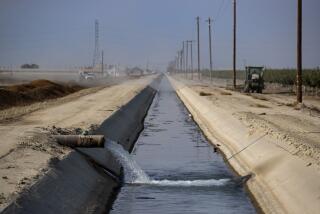Bush Plan Could Drain Effort to Clean Up Waters
- Share via
For the second straight year, President Bush is proposing to slash federal assistance to modernize aging sewer plants and prevent polluted runoff from tainting rivers and beaches, despite the Environmental Protection Agency’s own estimate that billions of dollars are needed to clean up the nation’s waters.
If approved by Congress, 2006 funding for the popular program to finance clean water improvements with low-interest loans will be cut nearly in half, from $1.35 billion in 2004 to $730 million. California estimates it would receive $50 million, compared with $95 million in 2004.
The clean water cuts are by no means the only environmental funding reductions in the Bush spending plan.
The EPA budget would be reduced by roughly 5.6% overall. Energy Department funding for efficiency and renewable energy sources such as wind and solar power would be cut by about 4%.
The National Oceanic and Atmospheric Administration budget would be trimmed by 8.3% despite the White House’s recently announced action plan to better safeguard and rehabilitate the oceans. The cuts include a 38% reduction to the National Ocean Service, which works on ocean preservation and exploration, and a near 12% drop in funding to the National Marine Fisheries Service, which works to curb overfishing.
“We have a limited amount of money to spend,” said Vice Adm. Conrad C. Lautenbacher Jr., undersecretary of Commerce for oceans and atmosphere. “There is no way to see programs that are not cut.”
The winners and losers of the spending plan reflect many of the Bush administration’s environmental priorities.
The Department of Interior, which manages about 20% of the nation’s land including national parks, would see its funding cut by about 1%. Its budget includes a boost to a project under its Healthy Forests initiative, which would allow more trees around communities to be cut down to prevent wildfires.
The Interior budget counts on higher offshore leasing fees from expanding oil and gas drilling in the Gulf of Mexico, which would, in turn, expand the budget for its Minerals Management Service. The budget is similarly optimistic on future revenue from opening Alaska’s Arctic National Wildlife Refuge to oil and gas leasing. It assumes Congress will approve the bitterly contested drilling plan, and that it will yield $2.4 billion in oil leasing fees by 2007, which would be split between the federal government and Alaska.
James T. Connaughton, chairman of the White House Council on Environmental Quality, said some of the perceived cuts were for local projects that had been added to the budget in past years by individual members of Congress.
Some of the environmental cuts reflect real progress, Connaughton said. For example, he said, the Energy Department was able to reduce environmental cleanup spending because it had made great gains at sites such as Rocky Flats, a former military base in Colorado that was contaminated with radioactive material.
Bush administration officials noted that the clean water loan program, which had doled out nearly $48 billion in loans since it began in 1987, was never intended to be funded forever by the federal government. Bush officials proposed that it be funded until 2011, when there would be a base of $3.4 billion to fund continued loans.
“We are committed to providing additional funding,” said Ben Grumbles, the EPA’s top water official. “But we are holding true to the original vision of the revolving loan fund that after some time, it would become self-sustaining.”
Grumbles stressed that the Bush administration was exploring other ways to help local agencies clean waterways. Options include management plans in which sewer plants, farmers and others discharging polluted wastewater could work together, and perhaps trade “pollution credits” with one another in a market-based system to clean entire watersheds.
Environmental groups blasted the proposed cuts to the loan fund, arguing that the federal government had a duty to help protect the public from waterways polluted with raw sewage, which can contain E. coli, salmonella and other disease-causing bacteria. Millions of Americans develop illnesses every year due to drinking or swimming in contaminated waters, according to the EPA.
“On the East Coast, we still have some cities with sewer pipes made of wood,” said Eric Eckl, spokesman for the American Rivers environmental group. “And here we have the federal government abandoning its responsibility to help local agencies address this problem.”
Water agencies said they would fight the cuts, which they characterized as a shift in philosophy by the Bush administration to have municipalities assume more responsibility for their water problems.
The EPA, the agencies noted, estimated in 2002 that there was a growing gap between spending on clean water improvements and the money needed, which could exceed $200 billion over the next two decades.
“As a nation, we are going backward,” said Ken Kirk, executive director of the Assn. of Metropolitan Sewerage Agencies, which represents more than 300 wastewater utilities around the country. The Bush administration, he said, is “basically telling the states and local communities to do it on their own, even though they can’t. We need a larger investment from the federal government if we have any chance of making progress.”
Times staff writer Tom Hamburger contributed to this report.
More to Read
Sign up for Essential California
The most important California stories and recommendations in your inbox every morning.
You may occasionally receive promotional content from the Los Angeles Times.










